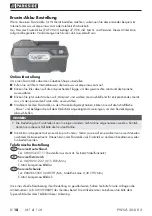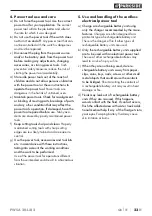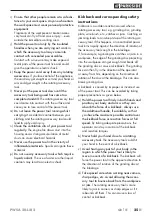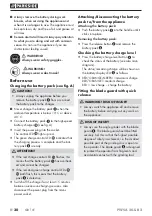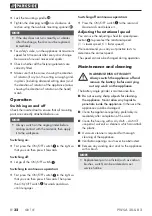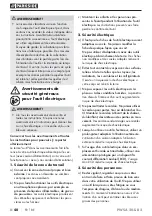
PWSA 20-Li B2
■
26
│
GB
│
IE
e)
Do not use chains or toothed saw blades.
Such accessories often cause a kickback or
loss of control over the power tool.
Special safety instructions for
grinding and abrasive cutting
a)
Use only the grinding accessories approved
for your power tool and the appropriate
blade guard for these grinding tools.
Grinding
tools which are not designed for the power tool
cannot be sufficiently shielded and are unsafe.
b)
Offset grinding discs must be fitted so that the
grinding surface does not protrude over the
level of the blade guard edge.
An improperly
fitted grinding disc which protrudes over the level
of the blade guard edge cannot be properly
guarded.
c)
The blade guard must be securely mounted
on the power tool and adjusted to ensure
maximum safety so that the smallest possible
amount of the grinding tool is open to the
operator.
The blade guard is designed to
protect the operator from fragments, accidental
contact with the grinding tool and sparks that
could ignite clothing.
d)
Grinding tools should only be used for the
recommended applications.
For example: Never grind with the side sur-
face of a cutting disc.
Cutting discs are de-
signed to remove material with the edge of the
disc. Any lateral application of force on these
grinding tools can lead to a breakage.
e)
Always use an undamaged clamping flange
of the correct size and shape for the selected
grinding disc.
Suitable flanges support the
grinding disc and reduce the risk of disc break-
age. Flanges for cutting discs can be different
to flanges for other grinding discs.
f)
Do not use worn grinding discs from larger
power tools.
Grinding discs for larger power
tools are not designed for the higher rotational
speeds of smaller power tools and can break.
Additional special safety instructions
for abrasive cutting
a)
Avoid any blockage to the cutting disc or
high contact pressure. Do not make any
excessively deep cuts.
Overloading the cut-
ting disc increases the stress and likelihood of
canting or blocking and thus the possibility of a
kickback or a breakage of the grinding tool.
b)
Avoid the area in front of and behind the
rotating cutting disc.
When you move the cut-
ting disc away from yourself in the workpiece, it
is possible, in the event of a kickback, that the
electrical tool along with the rotating disc is
thrown out directly towards you.
b)
If the cutting disc jams or you stop working,
switch the tool off and hold it steadily in
the workpiece until the disc has completely
stopped turning. Never attempt to pull a
rotating cutting disc out of a cut. This could
lead to kickback.
Identify and remove the
cause of the jam.
d)
Do not switch the power tool back on while
it is located in the workpiece. Allow the cut-
ting disc to reach its full speed before you
carefully continue the cut.
Otherwise, the disc
can jam, jump out of the workpiece or cause a
kickback.
e)
Support boards or large workpieces to re-
duce the risk of the cutting disc jamming and
causing a kickback.
Large workpieces can
bend under their own weight. The workpiece
must be supported on both sides of the disc:
both in the vicinity of the cutting disc and also
at the edge.
f)
Be particularly careful when making pocket
cuts into existing walls or other obscured areas.
The inserted cutting disc may cut into gas or
water pipes, electrical wiring or other objects
that can cause kickback.
Summary of Contents for 290849
Page 3: ...B A...
Page 4: ...D C...
Page 61: ...PWSA 20 Li B2 56 FR BE...
Page 117: ...PWSA 20 Li B2 112 ES...







